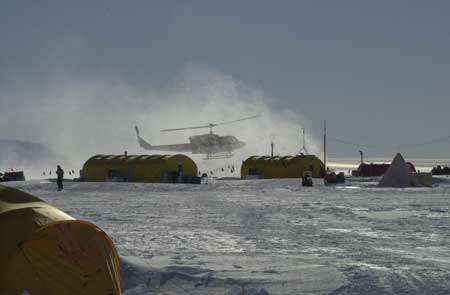Mountain retreatAntarctic Treaty meeting at Beardmore field camp marked unique moment in historyPosted December 31, 2010
[Editor’s Note: To quote a former Antarctic Sun editor … “Like the mythical town of Brigadoon, a village of tents appears on a glacial arm 50 miles from Beardmore Glacier about once a decade, then disappears.” Such a scientific field camp is again appearing in the Transantarctic Mountains this year. Former National Science Foundation Science, long celebrated for its starring role in bringing diplomats to the negotiating table to sign the 1959 Antarctic Treaty I joined the spirited and articulate group after hosting a long and meticulously planned day with them to show off America’s research station at the geographic South Pole Follow the 2010-11 Beardmore scientists
Twenty-five years later, and 50 years since the United States Senate ratified our nation’s adherence to the treaty, it’s worth looking back at a probably unrepeatable event in U.S. Antarctic Program For sure, the camp was an unusual field project in the U.S. Antarctic Program. Over more than two years, Malaysia, Antigua and Barbuda, had made no secret of their challenge to the original 12 Antarctic Treaty signatories — and the 20 nations that since had joined — that the treaty was the wrong way to manage Antarctica. They argued that the treaty had three fatal flaws: it was exclusive (not all nations were members), it was total (it covered all activities in Antarctica), and it was unaccountable (it was not subject to review by another body). “The Question of Antarctica” had been on the United Nations General Assembly agenda in 1983. The next year a U.N. report, with three volumes of annexes containing governments’ responses, stimulated another discussion at New York. Malaysia led the small chorus that thought a U.N.-centered regime should replace the treaty. The treaty nations were not enthusiastic about this initiative. James H. Zumberge, president of the University of Southern California and U.S. delegate to the Scientific Committee on Antarctic Research (SCAR) The camp was called Beardmore South because it was near Beardmore Glacier. It consisted of Jameways — insulated canvas huts with running water and heat and not much else. The 57 scientists and diplomats snored together, dressed together, ate together, and conferred. They punctuated the day-long sessions only with walks and the occasional ball game in the beautiful setting — along with their one-day excursion to Amundsen-Scott South Pole Station. “In an atmosphere conducive to free interchange, participants were able to gain a deeper appreciation of each others’ views ... while experiencing the practical realities of Antarctic operations,” Zumberge and Lee A. Kimball wrote in a 1986 National Academy Press book (Antarctic Treaty System – An Assessment) recording the workshop’s proceedings. The discussions, I recall, were overwhelmingly friendly but frank. The stance of scientists at the conference toward the nonjoiners seemed, mostly, “Get real.” William F. Budd (Australia) noted that “knowledge needs to be recognized as the primary motivation for the high level of continued interest” and that the treaty was formed only “after SCAR provided an international political framework.” Acknowledging that hopes for mineral resources had attracted attention to the continent (the treaty’s mining ban was six years in the future) he said, “economically viable exploitation in the foreseeable future is not a likely prospect.” The statement still seems valid a quarter-century later. 1 2 Next |



For USAP Participants |
For The Public |
For Researchers and EducatorsContact UsNational Science FoundationOffice of Polar Programs Geosciences Directorate 2415 Eisenhower Avenue, Suite W7100 Alexandria, VA 22314 Sign up for the NSF Office of Polar Programs newsletter and events. Feedback Form |


